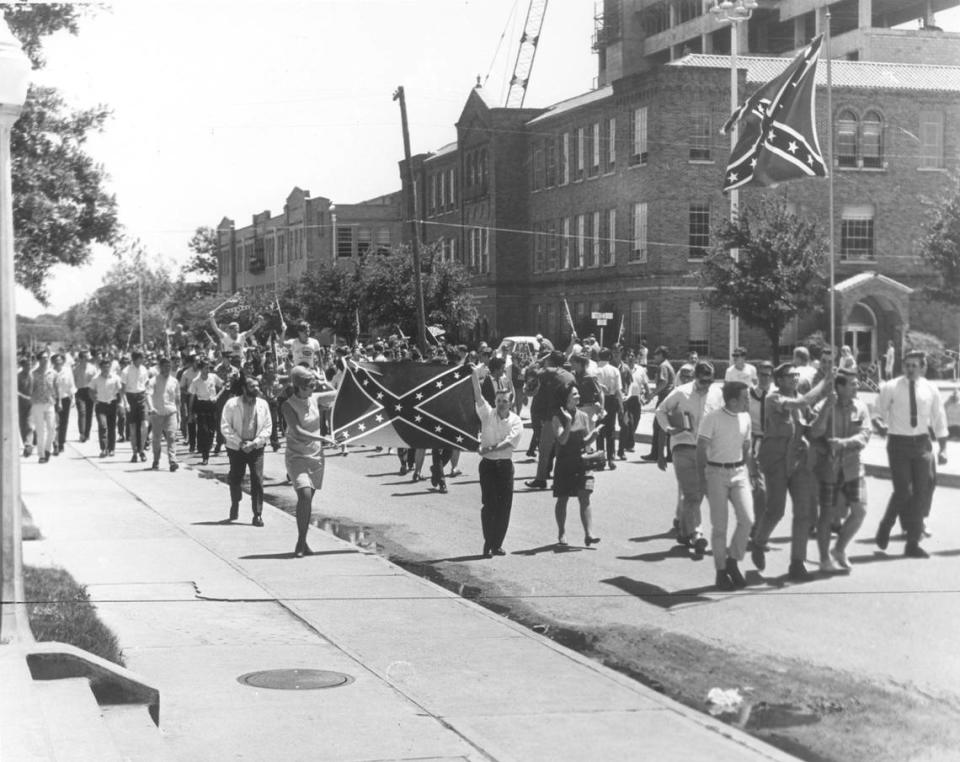Today they are the Mavericks, but UT Arlington once celebrated Texas’ Confederate past
Arlington State College President E. H. Hereford asked the sophomore class in 1951 to vote on a new school mascot: Rebels or Cadets. After two football seasons of 1-15-2, Hereford thought a new theme could boost school spirit. Students at the no-Blacks-allowed school unanimously chose the Rebels, selecting informally “Dixie” as their fight song.
During spring semesters, faculty and students celebrated Old South Week with mock slave auctions, Rebel yell contests, shooting guns at “Yankee” targets, and “jailing” any student not dressed in Old South costumes. A faculty member portraying Jefferson Davis called for the recruitment of students into the Confederate army. The Beauregard Confederate flag was sewed on team and band uniforms, hoisted on the flagpole in front of the student center, waved during games, and painted on campus trash cans. Student Center rooms were named after Confederate generals and Civil War battles. Furniture and draperies illustrated Confederate luminaries and Blacks in cotton fields.
Under threat of a lawsuit, the college partially integrated in 1962, allowing Blacks to attend classes but no access to campus housing or sports participation. After the college became the University of Texas at Arlington in 1967, the school hired Reby Cary in 1969 — its first Black faculty member — as assistant professor of history and associate dean of student affairs. In 1970, of the 14,028-student population, 176 were Black and 157 were Latino. Of the 1,032 college employees, five were Blacks and four had Spanish-surnames.
As the Civil Rights movement swept the country in the 1960s and 1970s, Black and Brown students asserted their voices. In October 1965, 25 Black and White students stood around the flagpole protesting the Confederate flag and sang “We Shall Overcome.” The Collegiates for Afro-American Progress wrote Dr. Frank Harrison, UTA president, a list of demands, including the immediate removal of the Rebel theme. Harrison skirted the issue by calling for student referendums, all ending with the White student majority voting to keep Johnny Reb.
After the Student Congress banned flying the Rebel banner in April, 1968, a black effigy was hung from the student center flagpole with a sign reading, “The Jig is up; the Flag is down.” Symbols of “KKK” were painted in front of the pole.

Kappa Alpha fraternity unfurled the Confederate flag at a pep rally on Oct. 17, 1969, ignoring Cary’s ardent, vocal request not to display the stars and bars. As the band struck up “Dixie,” Black students lunged for the flags, fists flew and students tumbled. Irate students charged the student center, seized Rebel flags, and burned them in front of the building. Rowdy conflicts erupted at football games, resulting in police interventions and Black student ejections.
Fearful of escalating violence and the racist image, the University of Texas Board of Regents voted 7-2 on Jan. 29, 1971, to abolish the Rebel theme. Chancellor Charles A. LeMaistre reasoned, “Put yourself in the other fellow’s shoes. The majority is not always right. I don’t think the minority should be obeyed all the time, but I do feel they should be listened to.”
In 1971, UTA students voted on a school mascot without the Rebel theme on the ballot as required by LeMaistre: Mavericks won. A sign on the student center wall jingled, “A Rebel I am/And a Rebel I’ll be/To a horse and cow/I’ll never agree!”
Author Richard J. Gonzales writes and speaks about Fort Worth, national and international Latino history.

